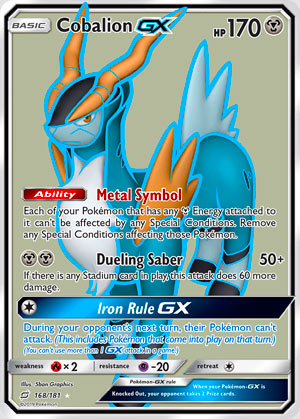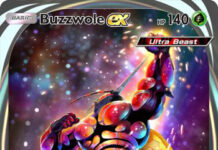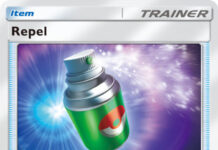
#8 Cobalion-GX
– SM Team Up
Date Reviewed:
February 6, 2019
Ratings Summary:
Standard: 3.03
Expanded: 3.10
Limited: 4.00
Ratings are based on a 1 to 5 scale. 1 is horrible. 3 is average. 5 is great.
Reviews Below:
 Vince Our 8th best card of Sun & Moon Team Up is Cobalion-GX! This is actually the only GX that I’ve considered to be on my personal Top 11 list because all the other GX in this set are underwhelming of the cost; it gives up more prizes if left untreated. An ideal GX that can see some degree of play would be to have an ability and two attacks. Other GXs that has no ability and only two or even three attacks don’t see much use in my eyes. Even if all two or three attacks are good, the fact that you can only pick one of them potentially undermine what would’ve been a good card. I don’t deny that those TAG TEAM cards can still be good if supported by external cards. I haven’t been using GX cards as frequently because they’re a bigger liability than single-prize Pokémon mostly because of GX counters. At the same time, using only single prize Pokémon is a chore to deal with if it keeps getting Knocked Out. So I guess I better alternate between the two. Cobalion-GX is one of the few GXs that I would actually consider using for certain decks, and that’s because it brings more to the table than just attacking. Cobalion-GX is a Basic Metal Type with 180 HP, weak to Fire, resist Psychic, and a retreat cost of one. It’s ability, Metal Symbol makes it that any Pokemon with any Metal energies can’t be affected by any Special Conditions, and removes those existing Special Conditions affecting the Pokemon. We’ve seen cards with abilities like this doing the same thing: BW Plasma Blast Virizion-EX’s Verdant Wind for Grass Energy; XY Slurpuff’s Sweet Veil and SM Guardians Rising Comfey’s Flower Shield for Fairy Energy. This does not protect OHKOs and residual damage other than Special Conditions such as Shrine of Punishment, but it does prevent Poison and Burn from finishing it off. There are some decks that utilizes Special Conditions as part of their strategy, but not often enough that you’ll see decks like those in tournaments. Still, it is a good ability that saw play during their time. Unlike Virizion-EX, Cobalion-GX doesn’t have any supporting attack similar to Emerald Slash that fetches Metal Energy. Instead, it is quite offensive. Duel Saber costs MM for 50 damage, plus 60 more damage if there is any Stadium card in play. 110 for 2 energy is still cheap, but the damage cap ruins the potential to hit key numbers, even with Choice Band. It can barely 2HKO the game except for Magikarp & Wailord-GX. Shrine of Punishment and Choice Band can reach 150, but Cobalion-GX will keep getting damaged between turns in the process. And then there’s Iron Law, which costs C and prevents your opponent’s Pokemon from attacking, even from newly played Pokémon. This is perhaps the true surefire way to actually buy a turn as opposed to GX attacks that heal all of your Pokemon. If you decide to not follow up with Duel Saber, than a retreat cost of one is easy to pay for, and that could be the energy that was used for Iron Law. And you can bring a different attacker. As good as it is, in Expanded, a well timed Pokémon Ranger will negate that lock. And other abilities and trainer cards can still damage, inflict Special Conditions, or other miscellaneous things. It also encourages the opponent to use cards that end their turn such as Kiawe or Steven’s Resolve because the opponent wouldn’t be able to attack anyways. Overall, the GX attack can be a double edged sword. Simply put, Cobalion-GX is yet another piece of metal type support, with even more cards from Japanese’s Full Metal Wall bringing in even more support for Metal Types. It can also be a nice fit for other decks using Rainbow Energy. For the most part, it is a solid card for both formats. In Expanded, it supports more Pokemon in exchange of the risk of its ability getting shut down, so the net worth could be pretty even or slightly unfavorable. In Limited, if you pulled one, it will definitely be a must run. In a 40-Card deck, all you need is just this Pokémon, most Metal Energies, some Stadium Cards, and some draw power, and you’ll be set to sweep. Preventing Special Conditions is just as useful there, and as far as the attack goes, ideally, you’ll use Iron Law to buy you a turn, and just keep using Duel Saber until you win. Up against Tag Team GXs, it’ll take three hits to take them down, but most of them have expensive attacks, so they won’t be attacking too soon. Ratings:
Conclusion: Putting it all together, Cobalion-GX isn’t the main attacker to use (secondary attacker at best), but it does bring a familiar ability that was proven useful before. Only time will tell if Special Conditions were to be important or not in the metagame. The never ending cycle goes on like this: if Special Conditions aren’t so dominant, Cobalion-GX won’t be needed; conversely, if they are, then Cobalion gets to save the day. Don’t forget about this card, especially if the never ending cycle is affecting our mentality! |
|
Cobalion GX (TEU 168) gallops into the Pokemon Trading Card Game out of the Team Up expansion set. This 170 HP Basic Metal Pokemon has an ability very similar to Magearna EX (STS 75). Metal Symbol, much like Mystic Heart, prevents Special Conditions. Mystic Heart went a little further preventing all effects of attacks – Metal Symbol won’t prevent energy from being discarded if an opponent has an attack that knocks energy off as a side effect of the attack – but Metal Symbol will prevent any abilities your opponent has which would inflict a Special Condition on any of your Pokemon with Metal Energy attached to them. Metal Symbol is again similar to Mystic Heart in that it doesn’t just include Metal Pokemon but any Pokemon that has Metal Energy attached. Cobalion’s only attack that does any damage is Dueling Saber, which does an unipressive fifty damage that is only minimally enhanced to 110 if there is a Stadium in play. Dueling Saber also costs two Metal attachments, so I doubt this Pokemon will see much play for its main attack. Iron Rule GX is a Colorless single attachment attack that prevents any and all of your opponent’s Pokemon from attacking, even ones that aren’t in play yet. Your opponent can still play all of their Trainer cards, attach energy, evolve Pokemon, and everything else they would normally do on a regular turn, they just can’t attack. And this isn’t something they can just Guzma around. You will not have a Pokemon KO’d from an attack the turn after you play Iron Rule GX. You might have them knocked out from Shrine damage or Poison or Burn or Feather Arrows, but you won’t lose a Pokemon from an attack. This could potentially give you a turn to catch up late in the game, maybe let you target down that three prize Tag Team GX and KO it to steal the game. Cobalion also has a single retreat cost, so the same energy that powered up Iron Rule GX could be used to promote another Pokemon that will do more damage than Dueling Saber. Overall, Cobalion isn’t terrible, its ability and GX attack could let it see some niche play as a one of TecH. I’ve pulled two of them, however, and have yet to even attempt to put even one of them into a decklist. Rating Standard: 2.5 out of 5 |
 Otaku Our eighth most promising pick of the latest expansion is Cobalion-GX (SM – 106/181, 168/181, 189/181). As a [M] Type, it’ll smack [Y] Types and some [W] Types for double damage due to Weakness, but has to deal with Resistance on most [L] Types; a favorable trade. I’m not seeing any anti-[M] effects worth mentioning, while among the pieces of [M]-Type support, Dhelmise (SM – Guardians Rising 59/145), Metal Frying Pan, and Reverse Valley seem to have proven themselves competitively, but the rest seemed to come up short or are just too new to have had much of a shot outside of the Japanese metagame. Cobalion-GX is a Basic Pokémon, so it’s fast to the field, requires minimal deck space, can function as your opening Pokémon, naturally works better with certain mechanics, enjoys some Stage support, and has to deal with certain Stage-based counters. As a Pokémon-GX, it gives up an extra Prize when KO’d and is treated differently by certain card effects; sometimes to its benefit but more often to its detriment. Being a Pokémon-GX usually means improved stats and effects, with improved HP and the presence of a GX-attack being the most obvious examples. In this case, 170 HP is on the low-end for typical Basic Pokémon-GX, but it still big enough that OHKO’s are going to require exploiting Weakness, exploiting GX-counters, or big hits in general. Fire Weakness is not a happy thing to have right now, with Blacephalon-GX variants being strong in both formats, with some newer stuff trying to establish a foothold in Standard and some older stuff still kicking around in Expanded. Three things that keep this from being quite as bad as it could be are Altar of the Sunne, Metal Frying Pan, and the fact that the top [R] Type attackers could already OHKO 170 HP even without Weakness (they’ll just have an easier time of it with Cobalion-GX). Any Resistance is welcome, and Psychic Resistance is still relevant in both Constructed Formats; 170 HP may not be massive for a Pokémon-GX, but it’s still enough that -20 damage can deny some attackers of their OHKO, especially if stuff live Metal Frying Pan and Reverse Valley are in play (the damage reductions all stack). Cobalion-GX doesn’t completely smash the stereotype of [M] Pokémon having high Retreat Costs, but it comes close as it retreats for just [C]. Even without expecting something higher just because I THINK (I haven’t run the numbers) most [M] Type Pokémon include literal heavies that tend toward higher Retreat Costs, [C] is just really good; easy to pay and recover from having paid. Cobalion-GX has an Ability, a regular attack, and a GX-attack. The Ability is “Metal Symbol”, which protects all of your Pokémon with a source of [M] Energy from Special Conditions and removes any that may have already been present. This means any Energy that can count as [M] doubles as a Full Heal, at least while Metal Symbol is working. Being an Ability on a Basic Pokémon, that isn’t a nitpick; with Ditto {*} it is even easier to slip Alolan Muk into just about any deck, and Silent Lab remains solid TecH for the Expanded Format. Your opponent can also get around this protection if they can afflict a Pokémon with Special Conditions who has no [M] Energy attached, whether by using an effect to discard what is already there or just targeting something already lacking the Energy. I’m not pointing out these gaps in its coverage because it is a bad Ability, but because we’ve seen similar effects before, so veterans or those who study even the game’s recent history already know how to deal with Metal Symbol… if their deck really cares about inflicting Special Conditions; most decks do not. “Dueling Saber” does 50 damage for [MM], or 110 if there is a Stadium card in play. Even without intentionally building your deck to spam Stadium cards, you should usually get that bonus. The catch is the specific Energy cost is somewhat unwieldy (less so in Expanded) and the specific damage amount will need multiple offensive buffs to score key OHKO’s or defensive buffs to make steady 2HKO’s worthwhile. “Iron Rule-GX” is almost the perfect pure stall attack; for just [C] your opponent’s Pokémon can’t attack next turn… even ones put into play after Iron Rule-GX was used. This effect doesn’t reside on any Pokémon; you can’t get around it by Benching Cobalion-GX or your own Active, or even by using Pokémon Ranger. The Energy cost is rarely going to be an issue as any Energy card which can be attached to Cobalion-GX covers it. Just don’t go thinking it is foolproof; it won’t save you from damage counter placement, decking out, Special Conditions, etc. unless they are coming from an attack the next turn. Of course, if Metal Symbol is working, any of your Pokémon with [M] Energy attached won’t have to worry about Special Conditions regardless. I mentioned how, in the past, we’ve seen effects like Metal Symbol before now. Multiple times, in fact, but we’re going to focus on two: Virizion-EX and Magearna-EX. Virizion-EX was a [G] Type Basic Pokémon-EX with 170 HP, [R] Weakness, [W] Resistance, the Ability “Verdant Wind” (same as Metal Symbol BUT for [G] Energy), and the attack “Emerald Slash” for [GC] (50 damage, attach up to two [G] Energy from your deck to one of your Benched Pokémon). Virizion-GX was seen in many, many decks. Decks built around basic Grass Energy liked it as an opener and a Bench-sitter, while almost everything else that ran a source of [G] Energy tried to include it as a Bench-sitter unless they had another effective means of dealing with Special Conditions OR just didn’t have the space. Sounds good for Colabion-GX, right? Nope; while attacking with Emerald Slash wasn’t that much easier, we had some fantastic [G] Type attackers for Virizion-EX to lead into, we had a lot of multi-Typed Energy floating around, we did not have as good of [R] Type decks, nor did we have something like Shrine of Punishment placing damage counters on Pokémon-EX between turns, and most decks were running Hypnotoxic Laser with Virbank City Gym. Magearna-EX is less similar to Cobalion-GX than Virizion-EX but close enough to be worth a semi-detailed explanation. A Basic [M] Type Pokémon-EX with 160 HP, [R] Weakness, [P] Resistance, Retreat Cost [C], the Ability “Mystic Heart” and the attack “Soul Blaster”. Mystic Heart offers protection from the effects of an opponent’s attacks if the Pokémon in question has a source of [M] Energy attached; useless against Special Conditions inflicted by Ability or Trainer but protecting against those from attacks, as well as other nasty attack-based effects that were running around at the time. Soul Blaster offered 120 damage for [MCC], though it placed an effect on Magearna-EX lowering its damage to 60 if it was used again the next turn. 120-for-three is still solid now and was a little more impressive back then. While not a Standard Format contemporary of Virizion-EX, Magearna-EX still didn’t exist in a format as hostile to it as modern Standard is to Pokémon-GX. The Modern Expanded Format isn’t especially friendly to it, either, but I think if some [M] decks were currently competitive, Magearna-EX would still see play. Unless something specific causes Cobalion-GX to clash with the strategy, decks running on [M] Energy OR focused on stall should run Cobalion-GX in either the Standard or Expanded Formats. It isn’t good enough to start running otherwise unnecessary basic Metal Energy, Rainbow Energy, etc. and there will be [M] decks and/or stall decks that ought to skip it; maybe they are avoiding all two-Prize Pokémon, maybe they think Magearna-EX is protection enough, or maybe they are trying to stall but they need something else Active (or even attacking). I am wondering what it can really do, with either Choice Band and multiple Dhelmise on the Bench or Metal Frying Pan with some healing or splitting the difference, Metal Frying Pan with some Dhelmise on the Bench. The Expanded Format may offer more of a reason to use it; it wasn’t that long ago we had a pretty solid beatdown deck for [M] Types. Consider yourself fortunate if you pull a Cobalion-GX at a Limited Format event; unless you pull several Stadium cards as well, I wouldn’t risk running Cobalion-GX as your only Pokémon, but Cobalion-GX and some [M] Energy should prove quite valuable in just about anything else. Ratings
Cobalion-GX isn’t a new staple by any stretch of the imagination, but it does have a place in many (most?) [M] Energy using decks and stall decks. I also like it just in terms of design and theming; Cobalion and Virizion are part of the same Legendary trio, and Cobalion-GX gives us a nice blend of relatively speedy offense and defense, which [M] Type decks could probably use. If you’re worried it made the top 11 due to my aesthetic preferences, though, don’t; Cobalion-GX wasn’t on my list at all! |
 aroramage The GX have had a major impact on the game since their inception. Dominating it in ways we never could have foreseen, and changing the landscape of the game as we know it. …wait, nope, sorry, that was “EX”. GX just kinda are here, and now only one is making a Top X list. What kind of world do we live in… Cobalion-GX is a Basic Metal Pokemon-GX, 170 HP, with a Fire Weakness, a Psychic Resistance, and a Retreat Cost of 2. Metal Symbol helps protect all Pokemon with Metal Energy attached from Special Conditions. Duel Saber then is a 2-for-50 that deals 60 more damage if a Stadium is play, making itself into a 2.1 kind of saber rather than a dual saber…I guess that’s what the e is for. Iron Law GX then costs only 1 Energy but does no damage and stops your opponent’s Pokemon from attacking during their next turn. Needless to say, Metal Symbol is probably the main highlight of this card. Duel Saber isn’t terrible, but it does require that Stadium to be effective, and while Iron Law GX is pretty useful for shutting your opponent down for a turn, unless you’re able to capitalize on the extra turn, it’s less likely to be used than not. But seeing an Ability like Metal Symbol so down on the list seems a bit strange. I mean, Special Conditions are still a big part of the game, right? Why wouldn’t you want to be immune from Paralysis or Poison? That’s why Virizion-EX saw play after all! Although comparing Colbalion-GX to Virizion-EX, the two share a lot of similarities, but the main difference here is in the timing of their release. With Virizion-EX, not only did she have a partner, but she came out in a time where Hypnotoxic Laser was a major part of every deck, while Cobalion-GX doesn’t necessarily lack in partners but doesn’t have as big a contentious threat as what HTL was. It’s not that there isn’t a need for him, it’s just that there isn’t something actively present in a majority of decks to warrant him. Regardless of this, I found Cobalion-GX to be highly favorable, so I stuck him high on my list. Yes, this is the first card on the countdown that’s on my list! No, this is not the only one that didn’t place as highly as I expected… Rating Standard: 3.5/5 (there are certainly problems that Cobalion-GX answers) Expanded: 4/5 (even if they aren’t currently problems) Limited: 4.5/5 (and it’s hard to argue with the power he provides) Arora Notealus: I can understand why some people would think Cobalion-GX doesn’t hold a major use in today’s game, but I wouldn’t say he’s completely useless. It may turn out that there are decks with Status Conditions as a big part of their plays, and Cobalion-GX can come in handy against such decks! Next Time: Can I get another ruling on that? |
We would love more volunteers to help us with our Card of the Day reviews. If you want to share your ideas on cards with other fans, feel free to drop us an email. We’d be happy to link back to your blog / YouTube Channel / etc. 😉
Click here to read our Pokémon Card of the Day Archive. We have reviewed more than 3500 Pokemon cards over the last 17+ years!




